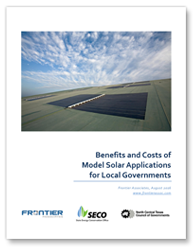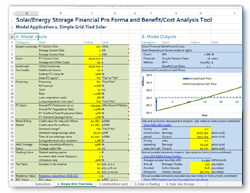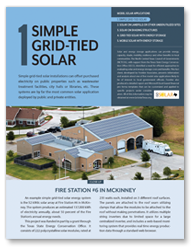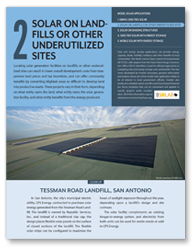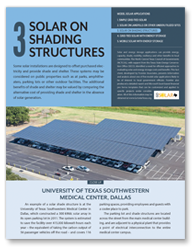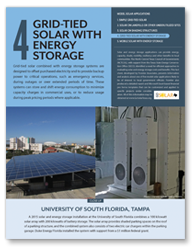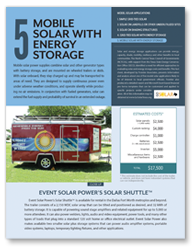Solar and energy storage applications can provide energy, capacity, shade, mobility, resiliency and other benefits to local governments. The North Central Texas Council of Governments (NCTCOG), with support from the Texas State Energy Conservation Office (SECO), identified a need for efficient approaches to evaluating solar and energy storage costs and benefits. These documents, developed by Frontier Associates, present information and analysis about five model solar applications likely to be of interest to local government officials. Frontier produced a detailed report, 2-page fact sheets, and Microsoft Excel-based financial pro forma templates that can be customized and applied to specific projects under consideration.
Benefits and Costs of Model Solar Applications for Local Governments
Solar/Energy Storage Financial Pro Forma and Benefit/Cost Analysis Tool
- Simple Grid-Tied Solar
- Solar on Landfills
- Solar on Shading Structures
- Grid-Tied Solar with Energy Storage
- Mobile Solar with Energy Storage
Benefits and Costs of Model Solar Applications for Local Governments
This report recommends two types of benefit-cost analysis that local governments may conduct to evaluate proposed solar applications. The first is an analysis of all reasonably quantifiable financial benefits and costs expected to accrue to the local government performing the analysis. The second recommended benefit-cost analysis takes into account additional impacts that accrue to the community. This report provides guidance to local government officials as they seek to understand the benefits and costs of potential investments in solar and storage on public facilities, brownfields or other underutilized lands.
Solar/Energy Storage Financial Pro Forma and Benefit/Cost Analysis Tool
This Microsoft Excel tool was produced by Frontier Associates for the North Central Texas Council of Governments (NTCOG). It is intended to serve as a starting point for local governments to analyze and quantify the direct financial, and additional community, benefits and costs associated with investments in solar or solar and energy storage systems. Each of the four worksheets illustrates the analysis of one model application described in the full report, Benefits and Costs of Model Solar Applications for Local Governments. Additional technical assistance may be obtained from Frontier Associates at 512-372-8778, or www.frontierassoc.com.
Download the Excel File (Right click > Save as)
Fact Sheets
These fact sheets provide a case study of each of the five model solar applications as well as show inputs and results from a benefit-cost model designed to illustrate current project economics for a selected solar application. Local government stakeholders may download the financial pro forma model and customize it to meet the special requirements of projects being considered for their communities.
Simple Grid-Tied Solar
Simple grid-tied solar installations can offset purchased electricity on public properties such as wastewater treatment facilities, city halls, libraries, etc. These systems are by far the most common solar application deployed by public and private entities.
Solar on Landfills
Locating solar generation facilities on landfills or other underutilized sites can result in lower overall development costs from inexpensive land prices and tax incentives, and can offer community benefits by converting blighted areas or difficult to develop land into productive assets. These projects vary in their form, depending on what entity owns the land, what entity owns the solar generation facility, and what entity benefits from the energy produced.
Solar on Shading Structures
Some solar installations are designed to offset purchased electricity and provide shade and shelter. These systems may be considered on public properties such as at parks, amphitheaters, parking lots or other outdoor facilities. The additional benefits of shade and shelter may be valued by comparing the alternative cost of providing shade and shelter in the absence of solar generation.
Grid-Tied Solar with Energy Storage
Grid-tied solar combined with energy storage systems are designed to offset purchased electricity and to provide backup power to critical operations, such as emergency services, during outages or over extended periods of time. These systems can store and shift energy consumption to minimize capacity charges in commercial uses, or to reduce usage during peak pricing periods where applicable.
Mobile Solar with Energy Storage
Mobile solar power supplies combine solar and other generator types with battery storage and are mounted on wheeled trailers or skids. With solar onboard, they stay charged up and may be transported to areas of need. They are designed to supply continuous power even under adverse weather conditions and operate silently while producing no air emissions. In conjunction with fueled generators, solar can extend the fuel supply and probability of survival in an extended outage.

